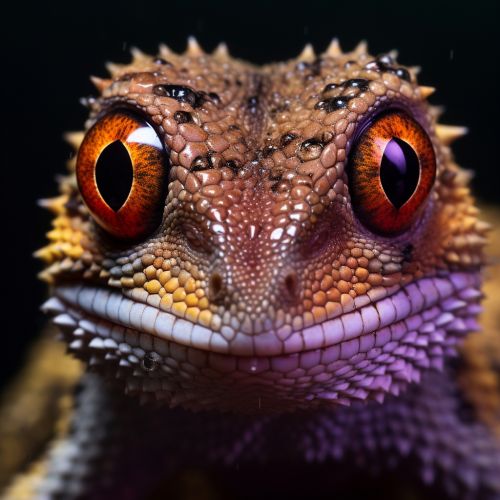Gecko
Taxonomy and Evolution
Geckos are members of the infraorder Gekkota, which is part of the larger order of Squamata, encompassing all lizards and snakes. The Gekkota infraorder is further divided into seven families, including the Gekkonidae, which contains the majority of gecko species.
Geckos are believed to have evolved around 100 million years ago, during the Cretaceous period. This is supported by fossil evidence, including the discovery of a well-preserved gecko with foot pads from this era. The evolution of geckos has been a subject of much scientific interest, particularly their adaptation to various environments and their unique physical characteristics.


Physical Characteristics
Geckos are small to medium-sized lizards, with most species measuring between 1.6 cm and 60 cm in length. They are known for their distinctive physical characteristics, including their wide-set eyes, which have a vertical slit pupil and lack eyelids, and their specialized toe pads that allow them to adhere to a wide range of surfaces.
The skin of a gecko is covered in small, granular scales that provide protection and aid in moisture retention. Some species also have the ability to change their skin color to blend with their environment, a form of camouflage known as crypsis.
Behavior and Ecology
Geckos are primarily nocturnal, active during the night and resting during the day. They are solitary animals and are generally not territorial, although some species will defend their home range from intruders. Geckos communicate through a series of chirps, clicks, and body movements.
Geckos are found in a wide range of habitats, from deserts to jungles, and have adapted to urban environments as well. They are insectivores, feeding primarily on insects and other small invertebrates. Some species are also known to consume fruit and nectar.
Reproduction
Geckos reproduce through sexual reproduction, with most species laying eggs. The number of eggs laid at a time varies by species, with some laying just one or two, while others lay up to a dozen. The eggs are typically hidden in a safe location, such as under a rock or in a tree crevice.
The incubation period for gecko eggs varies by species and environmental conditions, but generally ranges from 30 to 90 days. Once hatched, the young geckos are independent and receive no parental care.
Conservation
Many gecko species are considered to be of least concern by the International Union for Conservation of Nature (IUCN), due to their wide distribution and adaptability to various habitats. However, some species are threatened by habitat loss, pollution, and the pet trade.
Conservation efforts for geckos include habitat protection, regulation of the pet trade, and captive breeding programs. Research is also ongoing to better understand the ecology and behavior of geckos, which can aid in their conservation.
